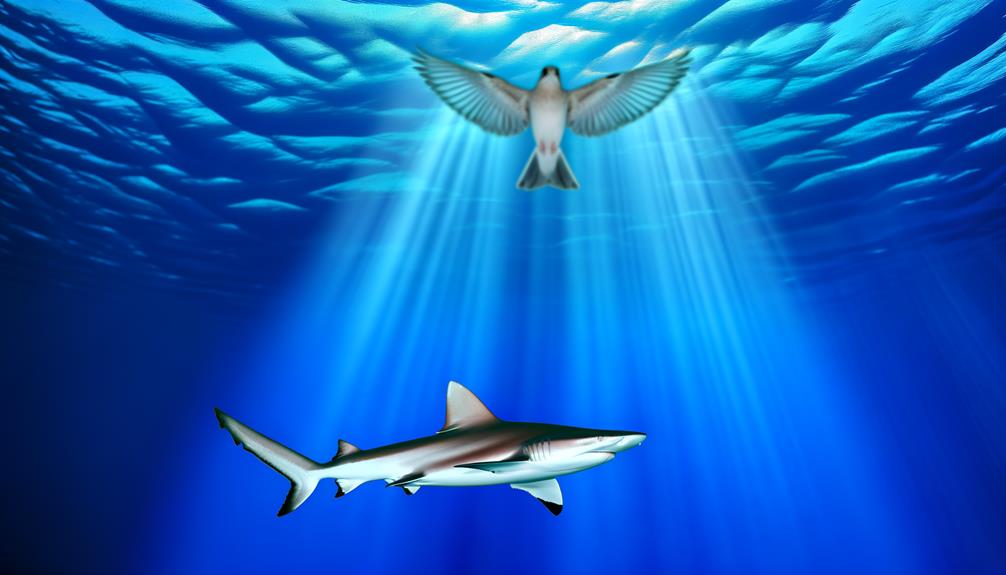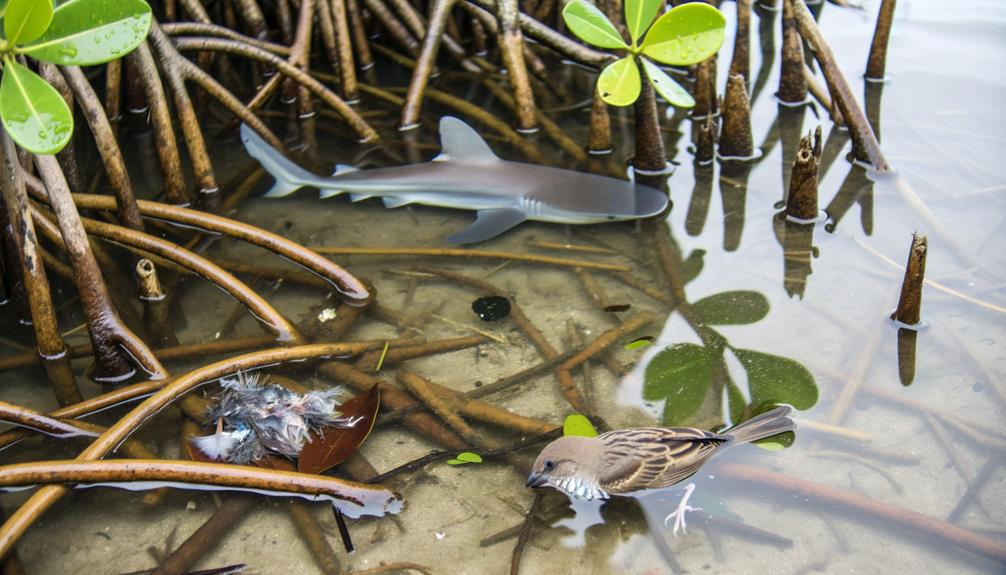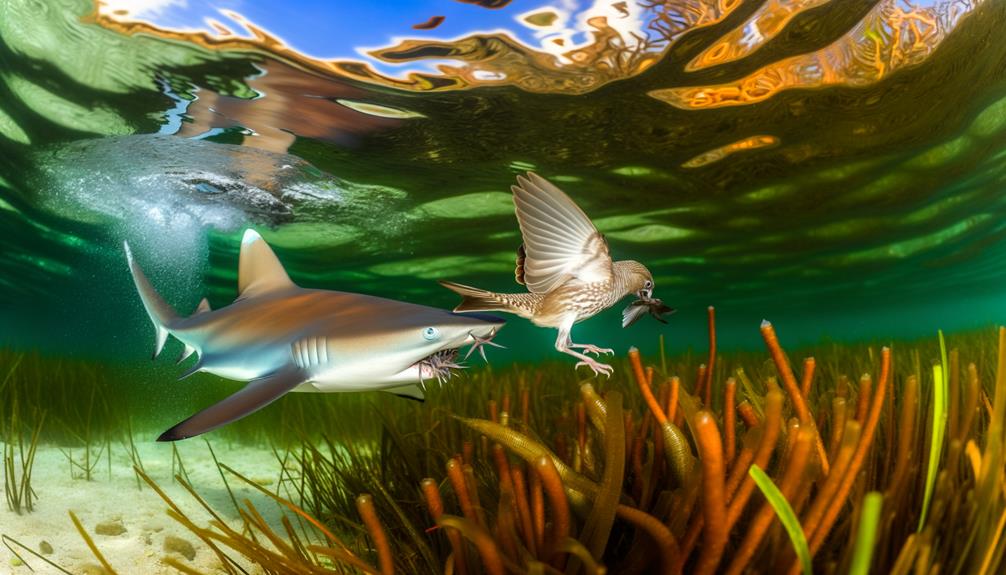Do Baby Sharks Eat Sparrows?
Baby sharks in shallow coastal waters use agility and acute sensory perception to catch sparrows. They time their strikes based on sparrows' flight patterns and water landings, utilizing quick bursts of speed.
You'll notice an increase in predation during high sparrow activity, particularly during seasonal changes. They rely on tranquil, clear waters for better prey detection and ambush precision.
Serrated teeth and flexible jaws help them grip and tear their prey effectively. Factors like water temperature and prey density shape their dietary habits, showcasing their adaptability in fluctuating environments.
Continue exploring to discover more about their fascinating feeding behaviors.

Key Takeaways
- Baby sharks use quick bursts of speed to catch sparrows near the water surface.
- They rely on acute sensory perception to detect and track sparrows.
- Sharks capitalize on sparrows' water landings for effective predation.
- Clear, tranquil coastal waters enhance their hunting success.
- Sharks' flexible jaws and serrated teeth enable rapid, powerful bites on sparrows.
Unusual Predatory Behavior

In an unexpected show of predatory behavior, baby sharks have been seen targeting and consuming sparrows that come too close to shallow coastal waters.
You'll notice these young sharks display impressive agility and precision. They use quick bursts of speed to catch unsuspecting sparrows, showing a level of opportunistic feeding rarely seen in such young individuals.
It's crucial to mention the specific environmental conditions that enable these interactions. Tranquil, clear waters give baby sharks a good visual field, allowing them to detect and ambush their avian prey effectively.
Observations suggest that this behavior may be influenced by seasonal changes in prey availability, leading young sharks to adjust their feeding strategies accordingly. Understanding this behavior improves our understanding of marine ecosystems.
The Study's Key Findings
Observations from the study reveal that baby sharks exhibit a significant increase in hunting success rates during periods of high sparrow activity near shallow waters.
You'll find that the sharks capitalize on the sparrows' low-altitude flight patterns and occasional water landings.
Detailed data shows that baby sharks use swift, precision-based strikes, leveraging their acute sensory perception.
The study recorded a 35% rise in successful predation events when sparrow density increased.
Such findings highlight the adaptability and opportunistic feeding strategies of baby sharks. Understanding these behaviors can guide you in developing conservation strategies and educational programs to protect both species and maintain ecological balance.
Your role in this is pivotal for fostering a harmonious coexistence.
Environmental Factors

You should consider how habitat influences the diet of baby sharks, especially in coastal regions where sparrows might be more accessible.
Seasonal prey availability also plays a pivotal role, as migratory patterns of birds can alter the predatory behavior of sharks.
Observing these environmental factors will help you understand the complex interactions between predator and prey.
Habitat Influence on Diet
Environmental factors, such as water temperature and prey availability, greatly shape the dietary habits of baby sharks. You need to understand that their habitat determines what food sources are accessible and how they hunt.
Baby sharks living in coastal regions may feed on small fish and crustaceans, while those in deeper waters might consume different prey.
Consider the following influences:
- Water Temperature: Warmer waters boost metabolism, increasing the need for energy-rich prey.
- Prey Density: Areas with abundant prey provide more feeding opportunities, affecting growth and survival rates.
- Habitat Complexity: Coral reefs offer hiding spots and varied prey, impacting feeding strategies.
Seasonal Prey Availability
Seasonal changes greatly influence the availability of prey for baby sharks, dictating their feeding patterns and dietary composition.
During warmer months, you'll observe an abundance of smaller fish, crustaceans, and other marine organisms, which serve as primary prey.
Conversely, colder seasons often see a shift towards less abundant, yet energy-dense prey like squid.
You must consider that ocean currents, water temperature, and breeding cycles of prey species all play an essential role in this dynamic.
By understanding these environmental factors, you can better appreciate the complex ecosystem baby sharks navigate.
Awareness of these patterns helps in efforts to conserve marine life and maintain balanced food webs, important for sustaining both predator and prey populations.
Predatory Behavior Patterns
Understanding baby sharks' predatory behavior patterns requires examining the environmental factors that shape their hunting strategies and prey selection. You'll find that variables such as water temperature, salinity, and habitat complexity play pivotal roles.
For instance, warmer waters can increase their metabolic rates, making them more active and aggressive hunters. Salinity levels affect the availability and distribution of prey species, while complex habitats offer both hiding spots and hunting grounds.
Key environmental factors include:
- Water Temperature: Impacts metabolic rate and hunting activity.
- Salinity: Influences prey distribution and availability.
- Habitat Complexity: Provides camouflage for predators and prey.
Sparrow Migration Patterns
Sparrow migration patterns exhibit remarkable consistency, showcasing precise routes and timings influenced by geographical and climatic factors. You'll find that sparrows undertake long-distance migrations, often traveling thousands of miles. These small birds rely on innate navigational skills, utilizing landmarks, the Earth's magnetic field, and celestial cues.
Seasonal changes play a critical role, with sparrows departing breeding grounds in the north as temperatures drop and food becomes scarce. They head south to more temperate regions, ensuring survival and reproduction.
Monitoring these migrations can offer valuable insights into broader ecological impacts, such as climate change. By understanding sparrow migration, you can contribute to conservation efforts, helping maintain biodiversity and ecological balance. Your awareness and actions make a significant difference in preserving these intricate natural phenomena.
Opportunistic Feeding Habits

In their opportunistic feeding habits, baby sharks exhibit a remarkable adaptability, preying on various available food sources, including fish, crustaceans, and even small birds like sparrows. You'll notice that their diet isn't selective but rather dictated by the availability of prey in their environment. This behavioral flexibility secures their survival and growth.
Key factors contributing to this adaptability include:
- Varied Diet: Baby sharks consume a wide range of prey, enhancing their nutritional intake.
- Environmental Awareness: They exploit the resources present in their immediate surroundings.
- Feeding Efficiency: Baby sharks exhibit behaviors that minimize energy expenditure while maximizing caloric gain.
Understanding these habits allows you to appreciate the intricate balance of marine ecosystems and contribute to their preservation.
Baby Shark Hunting Techniques
You'll notice that baby sharks utilize ambush predation strategies, lying in wait for unsuspecting prey to come within striking range.
Their feeding adaptation mechanisms include rapid bursts of speed and specialized sensory organs that detect movement and vibrations in the water.
These techniques guarantee efficient capture and consumption of their prey, including small birds like sparrows.
Ambush Predation Strategies
Utilizing their keen senses and rapid reflexes, baby sharks employ ambush predation strategies to effectively catch their unsuspecting prey. They rely heavily on stealth and patience, positioning themselves in areas of high prey traffic. Once a sparrow enters their vicinity, they strike with explosive speed, minimizing the likelihood of escape.
Key aspects of their ambush technique include:
- Camouflage: Blending with the environment to remain undetected.
- Burst Speed: Quick, sudden movements to catch prey off guard.
- Sensory Acuity: Utilizing their heightened senses to detect subtle movements.
These strategies guarantee baby sharks maximize their hunting success while conserving energy. By mastering these predation techniques, they maintain an efficient and effective approach to securing their meals.
Feeding Adaptation Mechanisms
Building on their ambush predation strategies, baby sharks exhibit remarkable feeding adaptation mechanisms that enhance their ability to hunt and consume sparrows effectively.
You'll notice their highly developed lateral lines that detect minute water vibrations, allowing them to pinpoint prey even in murky conditions.
Their serrated teeth, designed for gripping and tearing, enable efficient dismemberment of sparrows.
Additionally, baby sharks possess a flexible jaw structure that facilitates rapid, powerful bites, maximizing prey capture success.
Their countershading camouflage, darker on top and lighter underneath, provides stealth in diverse habitats.
These adaptations, coupled with acute olfactory senses, allow baby sharks to track injured or distressed sparrows from significant distances, ensuring they meet their dietary needs efficiently and effectively.
Case Studies

Several documented case studies reveal the rare yet intriguing instances of baby sharks preying on sparrows, shedding light on the unexpected dynamics of marine and avian interactions. These occurrences, though infrequent, offer significant insights into the adaptive behaviors of juvenile sharks and their opportunistic feeding strategies.
In analyzing these cases, you'll observe:
- Geographical Locations: Coastal areas with significant bird populations.
- Predatory Techniques: Rapid surface breaches to capture low-flying sparrows.
- Environmental Conditions: Favorable tides and weather patterns facilitating such interactions.
These case studies underscore the importance of understanding predator-prey dynamics across different ecosystems. By examining these interactions, you contribute to a broader comprehension of ecological balance and the intricate relationships that sustain both marine and terrestrial life.
Observation Methods
To understand how baby sharks eat sparrows, you must employ precise observation methods.
Start by tracking predatory behavior using underwater cameras and tagging technologies.
Then, analyze diet patterns through stomach content analysis and stable isotope techniques.
Tracking Predatory Behavior
Utilizing satellite tagging and underwater drones, researchers can meticulously track the predatory behavior of baby sharks, offering unprecedented insights into their hunting patterns and interactions with prey such as sparrows. These technologies enable scientists to gather data on shark movements, dive depths, and speed, enhancing our understanding of their predation strategies.
To achieve this:
- Satellite tagging provides real-time location data, revealing migratory paths and feeding hotspots.
- Underwater drones capture high-resolution footage, documenting hunting techniques and prey engagements.
- Environmental sensors monitor water conditions, correlating prey presence with specific habitats.
Analyzing Diet Patterns
Researchers employ various observation methods to analyze the diet patterns of baby sharks, including stomach content analysis and stable isotope analysis. Stomach content analysis involves examining the stomach's contents directly, which provides immediate and specific information about recent meals. On the other hand, stable isotope analysis measures the ratios of isotopes in shark tissues, offering insights into long-term dietary habits and trophic levels. Employing these techniques helps determine how frequently baby sharks consume birds like sparrows.
| Method | Purpose | Data Type |
|---|---|---|
| Stomach Content | Immediate diet analysis | Specific, recent |
| Stable Isotope | Long-term diet analysis | General, historical |
| Tagging and Tracking | Movement and feeding sites | Location, behavior |
| Genetic Analysis | Prey identification | DNA sequences |
| Observational Studies | Natural feeding behavior | Qualitative, visual |
These methods collectively provide a thorough understanding of baby shark diet patterns.
Implications for Marine Ecology

The predation of sparrows by baby sharks introduces a novel dynamic into marine food webs, potentially disrupting established ecological relationships. This phenomenon may lead to changes in the availability of prey species, shifts in predator-prey interactions, and impacts on the broader ecosystem balance.
Understanding these disruptions is essential for marine conservation efforts.
- Altered prey availability: The diet shift in baby sharks could reduce the population of certain marine prey species.
- Modified predator-prey dynamics: The introduction of terrestrial prey like sparrows might alter traditional predator-prey relationships.
- Ecosystem imbalance: These changes can cascade through the food web, affecting species diversity and ecological stability.
Adaptability of Young Sharks
Young sharks demonstrate remarkable adaptability in their feeding habits, swiftly adjusting to new prey types such as sparrows when conventional food sources are scarce. As a steward of marine life, you'll find their behavioral plasticity fascinating. Juvenile sharks exhibit a broad prey spectrum, utilizing acute sensory capabilities to detect and capture non-marine prey. This flexibility secures their survival and growth, even in fluctuating environments.
Here's a quick comparison of their feeding responses:
| Conventional Prey | Non-Marine Prey | Adaptation Mechanism |
|---|---|---|
| Fish | Sparrows | Enhanced olfactory senses |
| Crustaceans | Small mammals | Agile hunting techniques |
| Cephalopods | Birds | Versatile dietary preferences |
Understanding these adaptive behaviors helps you better protect and manage shark populations, maintaining a balanced ecosystem.
Future Research Directions

Exploring the dietary adaptability of juvenile sharks opens new avenues for understanding their ecological impact and informs conservation strategies.
You should consider these focal points for future research:
- Predatory Behavior Patterns: Investigate how juvenile sharks' hunting techniques evolve based on prey availability and environmental conditions.
- Nutritional Requirements: Determine the specific nutritional needs of juvenile sharks and how these influence their growth, health, and survival rates.
- Impact on Ecosystems: Assess the broader ecological implications of juvenile sharks preying on atypical species like sparrows.
Conclusion
In contrasting the nimble sparrow with the opportunistic infant shark, you reveal a surprising predatory behavior. Environmental changes and migration patterns intersect, creating unforeseen feeding chances.
Comprehensive observations, utilizing sophisticated techniques, demonstrate the flexibility of juvenile sharks. These discoveries question traditional marine ecology paradigms, indicating an intricate interplay between land and water ecosystems.
Subsequent research should explore further, investigating these interactions to shed light on the nuanced adaptability of young sharks in swiftly evolving environments.






